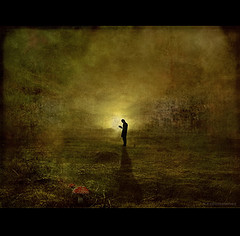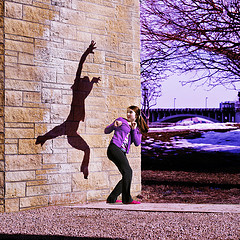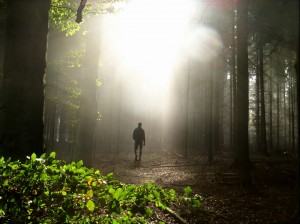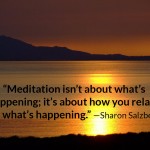
Does meditation have a dark side? Can a three thousand year old practice promoted by the Dalai Lama actually harm you? Well, the simple answer is yes. Like any new endeavor taken to extremes without proper guidance and preparation, it’s not without its risks.
But it’s complex, and if you are interested in meditation, it’s worth learning about. And I’ll be honest with you, until lilcently I never gave it much thought. After meditating for 20 years, the broad arc of my experience has been exceedingly positive.
But it’s included a healthy dose of pain, struggle, and suffering along the way. And I must admit, the emerging discussion around the shadow side of meditation has given me cause to reflect on my experiences.
Because meditation and mindfulness have hit mainstream, the conversation around meditation is evolving. Whereas most of the media touts mindfulness meditation as a panacea for our fast-paced first world woes, there is also a cautious minority ringing the warning bell.
Meditation, they say, is not all wine and cheese for the postmodern soul. In fact, there can be dire consequences if undertaken without correct supervision and guidance.
Meditation Boom & Bust?
 Of course, we’ve seen this pattern before with popular self-help fads. Every new free-radical fighting anti-oxidant superfood gets heralded and then debunked. New fitness fads crest and then get crushed with bruising critiques. Cross-fit exploded into the fitness industry and commanded cult-like devotion. Now, it’s becoming clear that it, too, has a real down-side.
Of course, we’ve seen this pattern before with popular self-help fads. Every new free-radical fighting anti-oxidant superfood gets heralded and then debunked. New fitness fads crest and then get crushed with bruising critiques. Cross-fit exploded into the fitness industry and commanded cult-like devotion. Now, it’s becoming clear that it, too, has a real down-side.
So is it really a surprise that meditation and mindfulness might be following a similar curve? In the West, it’s impulse first and evidence second. And lord knows, we all worship at the altar of the next big thing. Especially if it promises relief and release from the anxiety and stress of modern life.
So yes, mindfulness and meditation is probably being set up for the proverbial fall.
What’s a poor 2.5 thousand year old practice to do? Well, I guess what it’s always done. Keep going. There’s a reason this practice persists. It works. But I think all the new scrutiny is a welcome breath of fresh air. We are lucky to live in a time when a new window is opening and revealing novel information about this age-old practice.
Exploring The Dark Side of Meditation

In that light, I wanted to take an in-depth look at meditation’s shadow side and poke around a bit to get familiar with the conversation and share it with you. Like anything, you want to go in with your eyes wide open.
And let me be clear in case it’s not obvious, I am still biased and pro-meditation. But I think this discussion around the shadow side of meditation is important. It fills out the picture.
After all, it’s important to remember that for most of human history, esoteric practices like meditation were only taught to very advanced nuns and monks in the monastery. And even then, there were years of pre-requisite training before one could embark on the path of meditation.
We’ve come a long way in a short time, seeing meditation leap continents from East to West and from the monk’s cell to the Microsoft conference room. So it also makes sense that we may have missed some important turns on the road from there to here.
Tracking A Spectrum of Darkness

OK. Let’s take a look at the dark side of meditation. Inasmuch as I have followed the conversation, there seems to be a spectrum of darkness. On the darker side, there are instances of trauma, psychological dissociation, and psychotic breaks.
On the lighter (and perhaps ironic) side of the spectrum, we look at the unbridled embrace of mindful meditation by groups with the traditionally “unenlightened” values of self-advancement.
So how should you take all this in? I advise you to absorb it and be well-advised. Like skiing, bunji-jumping, binge-drinking, or starting a new relationship, there are associated risks. Trauma and injury may result.
But it’s also important to note that some of the more dire situations I share here were the consequence of extended meditation retreats where individuals were sitting for 10-18 hours a day for 10 days to several weeks on end. And I don’t have exact number, but the percentage of people who suffer the more adverse consequences seems to be a minority.
In the end, most of the prescription for this dark side is the same, if in doubt, you should exercise caution and seek expert guidance.
Chapter 1: The Dark Knight Project
Chapter 2: Dissociation Is Not Detachment
Chapter 3: Falling Into The Pit Of The Void
Chapter 4: Blinded By The Light
Chapter 5: Meditation For Strivers
Chapter 6: Integrating the Dark Side
1. The Dark Night Project
 Did you know that meditation can bring to the surface repressed emotional traumas that you may not be ready for? Did you know that it can also destabilize you? If not, you probably haven’t heard about the Dark Knight Project?
Did you know that meditation can bring to the surface repressed emotional traumas that you may not be ready for? Did you know that it can also destabilize you? If not, you probably haven’t heard about the Dark Knight Project?
This past June The Atlantic published a fascinating article highlighting the research of Brown University assistant professor Dr. Willoughby Britton. She calls her study “The Dark Night Project,” (recently renamed “The Varieties of Contemplative Experience”) and it documents the shadow side of meditation.
To be honest, I was astounded to learn about her half-way house for recovering meditators. Really? Recovering meditators? Yes, really.
It’s called Cheetah House, and it’s a sort of rehabilitation center for those who suffered traumatic meditation experiences. Many of these folks come to Dr. Britton as a last resort after unsuccessfully seeking out help from therapists and meditation teachers.
So what happened to these folks?
Many of them describe hellish experiences, often during meditation retreats, where they were assailed by negative emotions, thoughts, and powerful compulsions. In different ways, they were caught off guard by the inner forces unleashed through meditation.
For example, Dr. Britton describes experiences with her patients where meditation was a catalyst for things like breakups, psychotic breaks, and an inability to focus at work. Other stories chronicle otherwise well-adjusted young people losing all their drive, focus, and ambition as a result of deep meditation experiences.
To date, Dr. Britton has interviewed over 40 subjects for her study. She says that the majority were, “fairly out of commission, fairly impaired for between six months [and] more than 20 years.”
In her own words, Dr. Britton’s research is “an effort to document, analyze, and publicize accounts of the adverse effects of contemplative practices.” According to Britton, we have abundant data on the positive effects of meditation and mindfulness, but little to no data on the negative effects.
And in her own estimation of research into the effects of meditation, “We’re not being thorough or honest in our study of contemplative practice.” Interestingly, there is ample funding for research into the benefits of meditation, but scant resources or interest in supporting a study of the down side.
* * *
So what should we do with information like this? It’s a little like learning that your favorite aunt who could never do any wrong is exposed for being the opposite. But truth be told, as we have chronicled on this blog, meditation is hard. Part of that is struggling through disorienting, confusing, and often unpleasant experiences.
As The Atlantic rightly points out, “While meditators can better avoid difficult experiences under the guidance of seasoned teachers, there are cases where such experiences are useful signs of progress in contemplative development. Distinguishing between the two, however, remains a challenge.”
That definitely mirrors my experience. Almost all of the very intensely negative experiences I had became grist for the mill. Important learning opportunities that ultimately helped me to better understand myself.
And this leads us to the next and related dimension of meditation’s dark side.
(If you want to learn more about Dr. Brittons work, check out this excellent series of short video interviews over at Mindful. For an in-depth discussion ofDr. Britton’s work, I recommend her “Dark Side of the Dharma” Buddhist Geeks Podcast 2-part interview and subsequent follow-up here and here. Her work was also featured in two Time Magazine articles. You can learn about Cheetah House here.)
2. Dissociation Is Not Differentiation (Objectivity)
If The Dark Night Project investigates how meditation can induce trauma or trigger the release of a pandora’s box of repressed emotions stored in the unconscious, then Dr. Andrew Holecek looks at it from another related angle.
 In a recent blog post called “Is There a Dark Side of Meditation?”, the respected Buddhist author and teacher writes about how every noble quality has an opposite shadow side. And he describes one important way that this plays out in meditation.
In a recent blog post called “Is There a Dark Side of Meditation?”, the respected Buddhist author and teacher writes about how every noble quality has an opposite shadow side. And he describes one important way that this plays out in meditation.
“Here’s just one example of the shadow side. Because meditation cultivates a type of witness awareness (I’m witnessing my thoughts, I am not my thoughts), which if done properly can help us distance ourselves safely and beneficially from the contents of our mind, it can also exacerbate certain kinds of dissociative and depersonalization disorders.
There’s a subtle but critical difference between differentiation and dissociation. Differentiation is good. It helps us gain perspective on our thoughts and emotions. The “near enemy” of differentiation is dissociation, and that’s not so good. (Every noble quality has an ignoble shadow side, a “near enemy.” The near enemy of compassion is pity, of confidence it’s arrogance etc.).
Dissociation is a form of pathological distancing, even rejecting, of our thoughts and emotions. People who are prone to dissociative and depersonalization disorders should consult with a psychologist or psychiatrist, one familiar with meditation, to see if meditation is right for them.”
3. Falling Into The Pit Of The Void

Another quote from that Atlantic article that captured my attention came from a Buddhist teacher, Shinzen Young. Young teaches Vipassana meditation and here he highlights the difference between the normal struggle that one can experience in meditation and a deeper kind of struggle.
“Almost everyone who gets anywhere with meditation will pass through periods of negative emotion, confusion, [and] disorientation. …The same can happen in psychotherapy and other growth modalities. I would not refer to these types of experiences as ‘dark night.’ I would reserve the term for a somewhat rarer phenomenon.
Within the Buddhist tradition, [this] is sometimes referred to as ‘falling into the Pit of the Void.’ It entails an authentic and irreversible insight into Emptiness and No Self. Instead of being empowering and fulfilling … it turns into the opposite. In a sense, it’s Enlightenment’s Evil Twin.
This is serious but still manageable through intensive … guidance under a competent teacher. In some cases, it takes months or even years to fully metabolize, but in my experience the results are almost always highly positive.”
OK, I’ll be honest, I don’t totally understand what he’s talking about here. But it sure doesn’t sound good.
Obviously, if someone falls into the pit of the void, they are probably pretty deep in. Meaning, they are likely to have a teacher already. And I imagine for this to happen, they’re probably pretty far along the path already.
But as dire as this sounds, Shinzen seems confident that, like most experiences, it can be integrated and turned into an opportunity for growth.
Meditation & Religious Tradition
 And this is a critical point. It begs the question, what kind of preparation do people need for meditation, especially extended meditation retreats where a lot of the trauma occurs?
And this is a critical point. It begs the question, what kind of preparation do people need for meditation, especially extended meditation retreats where a lot of the trauma occurs?
Removing meditation from it’s original spiritual and religious contexts has implications. For one, we lose the deep framework of commitment which the tradition provides. That commitment acts like a firmament for experiences like suffering and trauma and helps people to “metabolize” those experiences.
Again, it’s important to remember that meditation wouldn’t begin for many novice monks and nuns until well into their monastic training. They had to practice their metaphysical scales for years before they were allowed to play their first spiritual song.
But these days, people go from a world of hyper stimulation to a sensory-deprived 10 day meditation retreat. They lack both the life experience and the knowledge of what they’re going to encounter in themselves. But also, there is little of the traditional context and training that religion provided.
 Even yoda had been training Luke Skywalker for weeks or months before he entered the dark cave to face himself. When Luke asks Yoda what’s in the cave, Yoda replies, “Only what you take with you.”
Even yoda had been training Luke Skywalker for weeks or months before he entered the dark cave to face himself. When Luke asks Yoda what’s in the cave, Yoda replies, “Only what you take with you.”
I have to assume that much of the emerging conversation about meditation’s dark side is tracking the consequences of this relatively new phenomenon. People practicing meditation in depth without a strong and stable context of commitment and preparation.
And yet, traditions have their own shadow-side when it comes to meditation.One of the greatest sages in my own meditation lineage, the Indian saint Ramana Maharshi, has been criticized for his anti-world bias. Many spiritual teachers and religious traditions subtly or explicitly favor meditative transcendence over worldly existence.
Like a moth drawn to the flame, very deep meditation experiences can hypnotize you into believing that true fulfillment is only found in the absolute dimensions of transcendent experience. From that perspective, the world is a place of pure suffering andwe only encounter our true self deep in meditative absorption.
But to my mind, meditation should help break down the divide between the transcendent and worldly dimensions. Meditation enriches my experience of this world, not the opposite.
4. Blinded By The Light
 Truth be told, when I started to reflect on some these articles, I realized that I had suffered some of the things they are talking about. I have definitely experienced a loss of focus, intense feelings of fear, lust, doubt, aimlessness and more.
Truth be told, when I started to reflect on some these articles, I realized that I had suffered some of the things they are talking about. I have definitely experienced a loss of focus, intense feelings of fear, lust, doubt, aimlessness and more.
However, for most of my journey I have been blessed to share a context of support with other meditators where I could share these experiences. Also, the teaching I followed had very strict instructions for how to deal with these experiences. Ignore them. So for me, that’s what I did. And eventually all the negative experiences passed when I did that.
But there is another angle that I experienced personally. It has to do with losing perspective and independence.
You see, meditation can put you in touch with powerful states of expanded awareness. Those experiences make you feel incredible.They are filled with a sense of intimacy and trust and communion. My teacher was powerful and charismatic. His presence could dramatically enhance the impact of these experiences.
But experiences like this can act like a drug. That can blinker your awareness in ways you might not suspect. For me, I inferred from those experiences with my teacher that he was special and that I could trust him absolutely.
In the process, I suspended some of my own critical and discriminating intelligence. I trusted this person so much that I always gave him the benefit of the doubt. In large part, that turned out to be a mistake.
Eventually it came to light that he wasn’t living his own teaching. After spending 15 years living and working in his ashram, it all collapsed. Deep down, this wasn’t a surprise, but I had been looking the other way for a long time. Still, it was devastating.
 I was a bona fide “true believer.” And although meditation certainly wasn’t to blame, it was part of the picture. What exactly does that mean?
I was a bona fide “true believer.” And although meditation certainly wasn’t to blame, it was part of the picture. What exactly does that mean?
One thing I have learned in reflecting on that experience is that intoxicating spiritual experiences can fuel your delusion. For example, I drew erroneous conclusions about my teacher (and myself) based on his charisma and his ability to transmit very powerful states of expanded awareness.
Those experiences fueled my conviction that we really had THE answer. Looking back that seems ridiculous to me, but there you have it.
My guess is that you’re unlikely to take up with a charismatic teacher any time soon, but it’s important for you to be aware that even though meditation can make you feel incredible, that experience doesn’t necessarily mean anything.
That’s a hard lesson. In the end, it’s just another experience. Sure, you can learn from it, in fact you should. But it’s important to maintain lots of space around these experiences and not draw too many conclusions.
I know from experience, it’s hard to do that. But I do believe meditation should help you become more awake and discriminating, not less. Clarity is hard to cultivate. Ecstatic and intoxicating experiences are just that. Intoxicating. For the sake of clarity, it’s important to be calm, cool, and collected in the face of them.
5. Meditation For Strivers
One a lesser scale of darkness, I enjoyed a recent article from The New Yorker called “Meditation For Strivers” that examined an interesting new phenomenon. Meditation, traditionally an ascetic art characterized by non-attachment and shedding acquisitive values is now the darling of groups whose values seem diametrically opposed.
Wall street, capitol hill, news anchors…they are all touting the benefits of mindfulness. According to these folks, it’s the new caffeine that can help you advance your career.
To the surprise and chagrin of business executives, the qualities required for meditation–grit, determination, perseverance, hard work, and commitment–aren’t all that different from the modern values that drive the world of profit and ROI.
Media outlets like Bloomberg and Forbes are both tracking and backing this phenomenon. Well what do you think about that? My thinking is pretty well summed up at the climax of the article.

“How did strivers everywhere come to appropriate a twenty-five-hundred-year-old philosophy of non-striving? On the spectrum of misappropriation, using self-advancement as a lure seems forgivable enough if it leads people to try a technique as subtly transformative as mindfulness. (Indeed, if personal betterment is America’s religion, such an approach might be seen as syncretic.) What can be lost by broadening access to a philosophy of liberation, even if a majority of people conflate it with the more vulgar priorities of our culture?”
I you are like me, you probably looked up syncretic. It generally means to combine conflicting beliefs.
And that’s what I like about this article and the time we’re living in. Of course people are going to misuse meditation and mindfulness. Or rather, it’s going to be lifted out of it’s original contexts and used or exercised in new ways. That’s how ideas evolve right? Isn’t that kind of mashup the very essence of our time? It’s an exciting turn of events.
On the flip side, embracing this view means that we lose the safe container of commitment that comes with cutting meditation off from its traditional roots. The great religious traditions have been secreting the flame at the heart of contemplative practice for millennia. And with it, they developed precise and subtle teachings for how to deal with many of the issues discussed in this post.
And personally, I love the deeply mystical and storied traditions around meditation.
6. Integrating The Dark Side
 But now, like it or not, that flame is spreading. And mostly, people are encountering meditation in contexts like this one. Online via blogs, youtube, and the web.
But now, like it or not, that flame is spreading. And mostly, people are encountering meditation in contexts like this one. Online via blogs, youtube, and the web.
So to me, the more interesting question is how do we harness this interest? And how do we provide as much context as possible?
That’s why we just took this brief high altitude look at some of the issues associated with the shadow side of meditation. And we probably just scratched the surface.
No doubt, this feels like an important conversation that we need to embrace. How you decide to respond to this information is obviously your call.
For me, as you’ve gathered, it doesn’t diminish my passion for practicing meditation in the least. More, it helps to flesh out the wider range of implications and experiences associated with meditation.
Meditation is not all peaches and cream. And if you really want to understand the landscape, these are real issues you should know about. It’s serious. Don’t go in lightly.
Is there reason to think that we are somehow different from novices in the monastery and that the same rules protecting them from the “dark side” of meditation don’t apply to the rest of us? Is our culture mature enough to handle it? I have no idea, but we’re sure going to find out.
What I can say is that meditation requires self awareness and maturity. For better and for worse, it can unleash powerful forces within you. It’s not, as Dr. Britton say, ” just a warm bath.”
In assessing the pitfalls associated with meditation, I like this quote cited in Dr. Holocek’s blog from one of my favorite contemporary Christian Mystics, Father Thomas Keating.
In the end, he says “It’s much more dangerous not to meditate.”
For a safe and simple introduction to meditation, try our free guided meditations.



Very interesting article Morgan and as you may recall that I was having a problem with the “Who am I ” guided meditation in the course , I wondering if “inner me” was given me a warning , that I was not prepared enough for it. I have not tried it since . This article has given me some reason maybe why that is?
Hi David. Thank you for the feedback. I think you did the right thing trusting your gut like that.
Very balanced! Excellent.
Thanks Mo!
This makes no sense at all. Meditation is diferent for all and this is just your view point, makes no sense to make an article like this its all irrelevant.
Hi Bee, I’m sorry, but I don’t understand your comment. The goal of this article is to share multiple perspectives on a dimension of meditation that is seldom spoken about when people are starting out in meditation. In my opinion, the fact that there is research on it being sponsored by Brown University makes this whole line of inquiry relevant, and at the very least interesting.
A very well written article. The negative side effects of meditation are really side effects of emptying deeper reservoirs of mind. Many of the things written in the article are inevitable consequences of inner exploration. This process is how detachment is strengthened until it becomes dispassion for whatever content bubbles up from mind.
My teacher only began to tell us about this stuff once it started happening because “it’s more dangerous not to meditate.” I couldn’t agree more. Thanks again!
Dear Jan, Thanks so much for your feedback and sharing your experience here. I couldn’t agree more. I think much of what I found in the research aligns with your point about “the inevitable consequences of inner exploration.”
Excellent! In the light of a recent 10 day silent retreat – this would be my word of caution for anyone considering meditation. I saw good people in emotional pain with no safety net – and they didn’t all ‘break through to the other side’.
I use simple mindfulness techniques to help clients lose weight. It’s a marvelous tool for living, but deep and prolonged meditation needs to be taken on under careful guidance and supervision.
Thank you Lesley. Very interesting to hear about your experience. I also participated in a number of long silent meditation retreats where some people didn’t “break through to the other side” as you put it. And sometimes with dire consequences. It was certainly the rare exception and not the rule, but it’s important to know that this is a side of the deeper meditation experience and expert guidance (and preparation) is key. As a good friend of mine put it, you’re more likely to see someone go off the deep end from a bad breakup than from a meditation retreat. I thought that was a compelling point. Nevertheless it’s still important to understand the terrain with meditation. And I agree, meditation really is a marvelous tool for living.